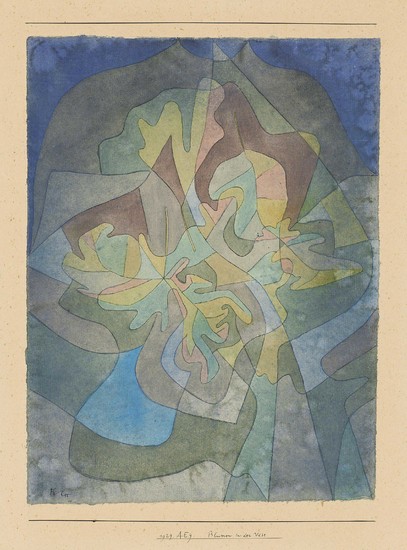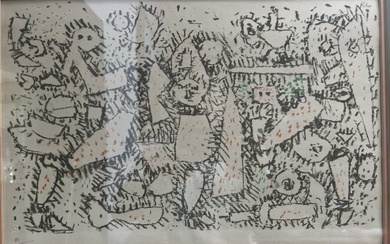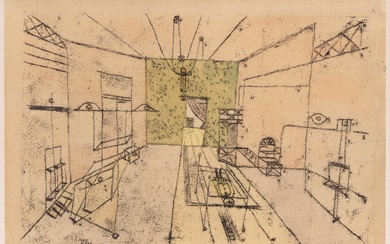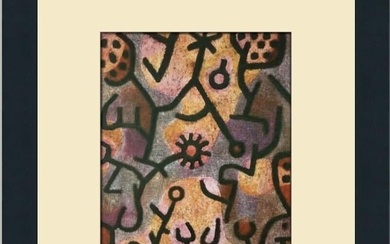Paul Klee (1879-1940), Blumen in der Vase (Flowers in the Vase)
Paul Klee (1879-1940)
Blumen in der Vase (Flowers in the Vase)
signed ?Klee? (lower left); dated, titled and inscribed ?1929. AE. 9. Blumen in der Vase? (on the artist?s mount)
watercolour and pen and ink on paper laid down on the artist?s mount
Image: 12 x 9 in. (30.5 x 23 cm.)
Artist's mount: 15 1/2 x 12 1/2 in. (39.5 x 31.5 cm.)
Executed in 1929
Provenance
Rudolf Probst [Galerie Neue Kunst Fides; Das Kunsthaus], Dresden and Mannheim, by 1930.
Kunsthaus Schaller, Stuttgart.
Robert H. & Ruth S. Weir, Charlotte, North Carolina.
Private collection, United States, until at least 2001.
Galerie Orlando, Zurich.
Acquired from the above by the family of the present owners on 2 March 2007.
BAUHAUS AND BEYOND: AN ABSTRACT CONVERSATION
For over thirty years Wassily Kandinsky and Paul Klee enjoyed one of the most fruitful and lasting friendships in modern art, working, exhibiting and living alongside one another during some of the most ground-breaking years of their careers. Forged in 1911, their relationship went from strength to strength, from its fledgling stages in Munich where the two artists exhibited together as part of the Der Blaue Reiter group, to the intense bond they developed during their tenures at the Bauhaus, first in Weimar and then in Dessau. This friendship continued into their later years, as they remained in touch via correspondence, despite the geographical distance that separated them. Built on a deep sense of camaraderie and mutual respect, the two artists enjoyed a close bond, sharing important life events and celebrations with one another, offering support in times of conflict and need, and assisting one another with both their personal and artistic affairs. Throughout their relationship, they engaged in a lively artistic dialogue, and traces of the influence they exerted on each other?s working practices remain visible to this day. Although it may be argued that an element of professional rivalry simmered beneath the surface of their friendship, their bond was never tested by petty jealousy or drama. Rather, their individual successes seemed to spur one another on, further encouraging them to boldly experiment in their own work and push the boundaries of their art to new levels.
Klee and Kandinsky both embarked upon their artistic education in Munich during the opening years of the twentieth-century, simultaneously studying at the city?s Kunstakademie (Academy of Fine Arts) under the tutelage of the greatly admired painter Franz von Stuck. However, their relationship at this time remained quite distant, with Klee claiming he could only ?dimly recollect Kandinsky? from their classes together (Klee, quoted in M. Baumgartner, A. Hoberg, & C. Hopfengart, eds., Klee & Kandinsky: Neighbours, Friends, Rivals, exh. cat., Munich & London, 2015, p. 13). Indeed, it was not until a decade later, in October 1911, that Klee and Kandinsky would become personally acquainted with one another thanks to the intercession of the Swiss artist, Louis Moilliet. By this stage of their lives, the two artists were in fact neighbours, living on the same street in the artist?s quarter of Schwabing in Munich. Kandinsky recorded his first impressions of the young artist in a letter to his close friend Franz Marc, explaining that ?There is certainly something there in his soul? (Kandinsky, quoted in ibid, p. 36). Klee, meanwhile, noted in his diary that: ?Personal acquaintance [with Kandinsky] has given me a somewhat deeper confidence in him. He is somebody and has an exceptionally fine, clear mind? (Klee, quoted in ibid, p. 36). According to Klee, the pair spoke about Kandinsky?s plans to establish a new society of artists and agreed on the trolley ride home to meet more often in the future, a promise they kept over the following months with visits from house to house growing increasingly frequent.
Their meeting came at a pivotal time in Kandinsky?s career, as he officially departed the artist?s group Neue Künstlervereinigung München (NKVM), of which he had been a founding member, to establish the Der Blaue Reiter group with his friend Franz Marc. Klee, in his role as special correspondent for the Swiss periodical Die Alpen, reviewed the Der Blaue Reiter Exhibition in December 1911, and delivered a highly positive account of the event to his readers. The article reserved special praise for Kandinsky, identifying him as ?the boldest? among the artists involved, and emphasising the bravery he showed in following his own artistic path in the face of opposition (Klee, quoted in ibid, p. 37). Through his contact with Kandinsky, Klee was soon embraced by the wider circle of artists involved with Der Blaue Reiter, and joined the group for their second exhibition in 1912, subtitled ?Black and White? (Schwarz-Weiss), in which he was represented by seventeen drawings.
The friendship between Kandinsky and Klee continued to grow throughout the years immediately preceding the First World War, with the older artist making introductions on Klee?s behalf to his various contacts, and encouraging collectors such as Arthur Jerome Eddy to purchase the young artist?s work. In 1912, Klee received a copy of Kandinsky?s recent publication On the Spiritual in Art from the author, and the personal dedication included on the frontispiece points towards the growing warmth of their friendship, reading: ?To my dear friend Paul Klee, affectionately Kandinsky.? Klee?s son Felix would later recall numerous visits to Kandinsky?s home with his father during this time and as the two men grew closer they began to exchange their own works as tokens of their friendship. Thus began an inspiring and thought-provoking artistic dialogue between the two painters, whose impact could be felt in Klee?s oeuvre almost immediately. Indeed, it was as a result of this contact with Kandinsky, and in particular his exposure to the artist?s colour experiments, that Klee began to develop a new, and increasingly personal, relationship to colour in his own art.
The outbreak of the First World War led to a prolonged separation between the two artists, as Kandinsky was forced to flee Germany as an enemy alien. Although they met briefly in Switzerland in the summer of 1914, the pair would not reconnect again for almost eight years. By this time, their professional fortunes had dramatically altered ? Klee was now a widely acclaimed painter, experiencing critical and commercial success across Europe, and achieving new levels of popularity among the public. In 1921, he had been invited to become a Master at the Bauhaus in Weimar by Walter Gropius, a position which granted him a new degree of financial security, as well as a heightened professional standing. Kandinsky, on the other hand, had been absent from the German art scene for a number of years, working on the reorganisation of the cultural establishment in Russia following the revolution. He had left his post as a teacher at the Free State Art Studios (SVOMAS) after encountering the ideological limitations of the Constructivists, who rejected his subjectivism and spiritualism, and returned to Germany where he was, once again, the topic of fierce controversy. Upon his arrival in Berlin, he sent a letter to Klee at the Bauhaus, enquiring about the living standards in Weimar and expressing his desire to see his old friend once again. Just a few months later, Klee would assist Kandinsky and his wife in their own move to Weimar, as his friend also joined the faculty of the Bauhaus. This ushered in a new phase in their friendship, as they came to know each other as colleagues of equal standing.
In Weimar, the friends often shared an inexpensive meal together, or visited one another?s homes in the evening to listen to jazz and tango records. Kandinsky was one of the few people who could elicit conversation from Klee, often peppering him with questions that were interesting enough for him to answer. Kandinsky, meanwhile, trusted Klee?s opinion enough to show his friend his latest experiments. ?There are not many colleagues I like to show my pictures to,? he explained, ?but Klee is a great and very rare exception, and besides, I highly respect his judgement? (Kandinsky, quoted in ibid., p. 267). Their friendship became much closer than it had been in Munich, as they came to know each other on a more personal level, working alongside one another on a daily basis. They revived their tradition of gifting each other works of art on special occasions, exchanging small paintings and works on paper on each other?s birthdays and at Christmas. For example, to celebrate Kandinsky?s sixtieth birthday, Klee created the work Letter-Paper Picture for 5 December 1927, featuring the artist?s name alongside inscriptions which refer to the various places Kandinsky had called home over the previous decade: Moscow, Munich, Weimar and Dessau. These works acted as both expressions of their friendship, but also as markers of their ongoing artistic dialogue with one another, as they pursued similar motifs, themes, and experimental techniques.
When the Bauhaus moved to Dessau in 1926, the closeness between Klee and Kandinsky increased even further. This was largely driven by the fact that they became, once again, neighbours, living together first in rented accommodation, and then side-by-side in two semi-detached Master?s Houses on the new Bauhaus site. With just a single wall separating them in both cases, the pair?s friendship reached new levels of familiarity and intimacy. Here, Klee and Kandinsky quickly fell into an easy routine, working and teaching alongside one another, regularly socialising together with their wives, and taking long walks in the valley of the Elbe River. Tea on the terrace became something of an afternoon ritual for the pair, with numerous photographs from the period showing the two at a table outside their house, enjoying one another?s company. Indeed, these snapshots, as well as those taken on a joint holiday to France...
View it on
Sale price
Estimate
Time, Location
Auction House
Paul Klee (1879-1940)
Blumen in der Vase (Flowers in the Vase)
signed ?Klee? (lower left); dated, titled and inscribed ?1929. AE. 9. Blumen in der Vase? (on the artist?s mount)
watercolour and pen and ink on paper laid down on the artist?s mount
Image: 12 x 9 in. (30.5 x 23 cm.)
Artist's mount: 15 1/2 x 12 1/2 in. (39.5 x 31.5 cm.)
Executed in 1929
Provenance
Rudolf Probst [Galerie Neue Kunst Fides; Das Kunsthaus], Dresden and Mannheim, by 1930.
Kunsthaus Schaller, Stuttgart.
Robert H. & Ruth S. Weir, Charlotte, North Carolina.
Private collection, United States, until at least 2001.
Galerie Orlando, Zurich.
Acquired from the above by the family of the present owners on 2 March 2007.
BAUHAUS AND BEYOND: AN ABSTRACT CONVERSATION
For over thirty years Wassily Kandinsky and Paul Klee enjoyed one of the most fruitful and lasting friendships in modern art, working, exhibiting and living alongside one another during some of the most ground-breaking years of their careers. Forged in 1911, their relationship went from strength to strength, from its fledgling stages in Munich where the two artists exhibited together as part of the Der Blaue Reiter group, to the intense bond they developed during their tenures at the Bauhaus, first in Weimar and then in Dessau. This friendship continued into their later years, as they remained in touch via correspondence, despite the geographical distance that separated them. Built on a deep sense of camaraderie and mutual respect, the two artists enjoyed a close bond, sharing important life events and celebrations with one another, offering support in times of conflict and need, and assisting one another with both their personal and artistic affairs. Throughout their relationship, they engaged in a lively artistic dialogue, and traces of the influence they exerted on each other?s working practices remain visible to this day. Although it may be argued that an element of professional rivalry simmered beneath the surface of their friendship, their bond was never tested by petty jealousy or drama. Rather, their individual successes seemed to spur one another on, further encouraging them to boldly experiment in their own work and push the boundaries of their art to new levels.
Klee and Kandinsky both embarked upon their artistic education in Munich during the opening years of the twentieth-century, simultaneously studying at the city?s Kunstakademie (Academy of Fine Arts) under the tutelage of the greatly admired painter Franz von Stuck. However, their relationship at this time remained quite distant, with Klee claiming he could only ?dimly recollect Kandinsky? from their classes together (Klee, quoted in M. Baumgartner, A. Hoberg, & C. Hopfengart, eds., Klee & Kandinsky: Neighbours, Friends, Rivals, exh. cat., Munich & London, 2015, p. 13). Indeed, it was not until a decade later, in October 1911, that Klee and Kandinsky would become personally acquainted with one another thanks to the intercession of the Swiss artist, Louis Moilliet. By this stage of their lives, the two artists were in fact neighbours, living on the same street in the artist?s quarter of Schwabing in Munich. Kandinsky recorded his first impressions of the young artist in a letter to his close friend Franz Marc, explaining that ?There is certainly something there in his soul? (Kandinsky, quoted in ibid, p. 36). Klee, meanwhile, noted in his diary that: ?Personal acquaintance [with Kandinsky] has given me a somewhat deeper confidence in him. He is somebody and has an exceptionally fine, clear mind? (Klee, quoted in ibid, p. 36). According to Klee, the pair spoke about Kandinsky?s plans to establish a new society of artists and agreed on the trolley ride home to meet more often in the future, a promise they kept over the following months with visits from house to house growing increasingly frequent.
Their meeting came at a pivotal time in Kandinsky?s career, as he officially departed the artist?s group Neue Künstlervereinigung München (NKVM), of which he had been a founding member, to establish the Der Blaue Reiter group with his friend Franz Marc. Klee, in his role as special correspondent for the Swiss periodical Die Alpen, reviewed the Der Blaue Reiter Exhibition in December 1911, and delivered a highly positive account of the event to his readers. The article reserved special praise for Kandinsky, identifying him as ?the boldest? among the artists involved, and emphasising the bravery he showed in following his own artistic path in the face of opposition (Klee, quoted in ibid, p. 37). Through his contact with Kandinsky, Klee was soon embraced by the wider circle of artists involved with Der Blaue Reiter, and joined the group for their second exhibition in 1912, subtitled ?Black and White? (Schwarz-Weiss), in which he was represented by seventeen drawings.
The friendship between Kandinsky and Klee continued to grow throughout the years immediately preceding the First World War, with the older artist making introductions on Klee?s behalf to his various contacts, and encouraging collectors such as Arthur Jerome Eddy to purchase the young artist?s work. In 1912, Klee received a copy of Kandinsky?s recent publication On the Spiritual in Art from the author, and the personal dedication included on the frontispiece points towards the growing warmth of their friendship, reading: ?To my dear friend Paul Klee, affectionately Kandinsky.? Klee?s son Felix would later recall numerous visits to Kandinsky?s home with his father during this time and as the two men grew closer they began to exchange their own works as tokens of their friendship. Thus began an inspiring and thought-provoking artistic dialogue between the two painters, whose impact could be felt in Klee?s oeuvre almost immediately. Indeed, it was as a result of this contact with Kandinsky, and in particular his exposure to the artist?s colour experiments, that Klee began to develop a new, and increasingly personal, relationship to colour in his own art.
The outbreak of the First World War led to a prolonged separation between the two artists, as Kandinsky was forced to flee Germany as an enemy alien. Although they met briefly in Switzerland in the summer of 1914, the pair would not reconnect again for almost eight years. By this time, their professional fortunes had dramatically altered ? Klee was now a widely acclaimed painter, experiencing critical and commercial success across Europe, and achieving new levels of popularity among the public. In 1921, he had been invited to become a Master at the Bauhaus in Weimar by Walter Gropius, a position which granted him a new degree of financial security, as well as a heightened professional standing. Kandinsky, on the other hand, had been absent from the German art scene for a number of years, working on the reorganisation of the cultural establishment in Russia following the revolution. He had left his post as a teacher at the Free State Art Studios (SVOMAS) after encountering the ideological limitations of the Constructivists, who rejected his subjectivism and spiritualism, and returned to Germany where he was, once again, the topic of fierce controversy. Upon his arrival in Berlin, he sent a letter to Klee at the Bauhaus, enquiring about the living standards in Weimar and expressing his desire to see his old friend once again. Just a few months later, Klee would assist Kandinsky and his wife in their own move to Weimar, as his friend also joined the faculty of the Bauhaus. This ushered in a new phase in their friendship, as they came to know each other as colleagues of equal standing.
In Weimar, the friends often shared an inexpensive meal together, or visited one another?s homes in the evening to listen to jazz and tango records. Kandinsky was one of the few people who could elicit conversation from Klee, often peppering him with questions that were interesting enough for him to answer. Kandinsky, meanwhile, trusted Klee?s opinion enough to show his friend his latest experiments. ?There are not many colleagues I like to show my pictures to,? he explained, ?but Klee is a great and very rare exception, and besides, I highly respect his judgement? (Kandinsky, quoted in ibid., p. 267). Their friendship became much closer than it had been in Munich, as they came to know each other on a more personal level, working alongside one another on a daily basis. They revived their tradition of gifting each other works of art on special occasions, exchanging small paintings and works on paper on each other?s birthdays and at Christmas. For example, to celebrate Kandinsky?s sixtieth birthday, Klee created the work Letter-Paper Picture for 5 December 1927, featuring the artist?s name alongside inscriptions which refer to the various places Kandinsky had called home over the previous decade: Moscow, Munich, Weimar and Dessau. These works acted as both expressions of their friendship, but also as markers of their ongoing artistic dialogue with one another, as they pursued similar motifs, themes, and experimental techniques.
When the Bauhaus moved to Dessau in 1926, the closeness between Klee and Kandinsky increased even further. This was largely driven by the fact that they became, once again, neighbours, living together first in rented accommodation, and then side-by-side in two semi-detached Master?s Houses on the new Bauhaus site. With just a single wall separating them in both cases, the pair?s friendship reached new levels of familiarity and intimacy. Here, Klee and Kandinsky quickly fell into an easy routine, working and teaching alongside one another, regularly socialising together with their wives, and taking long walks in the valley of the Elbe River. Tea on the terrace became something of an afternoon ritual for the pair, with numerous photographs from the period showing the two at a table outside their house, enjoying one another?s company. Indeed, these snapshots, as well as those taken on a joint holiday to France...







